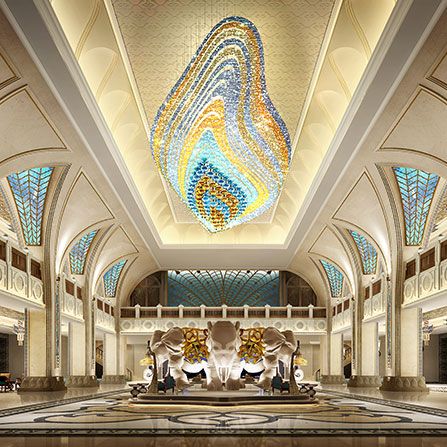Designing Effective Wayfinding Systems: A Comprehensive Approach in English
Unlocking the Secrets of Effective Wayfinding: A Comprehensive Guide to Signage System Design
Ever walked into a mall or a museum and felt like you were in a labyrinth? That's where a well-thought-out signage system comes into play. But what exactly is a signage system, and how do you design one that's not just functional but also stylish? Let's dive into the world of wayfinding and uncover the secrets to creating a signage system that's as user-friendly as it is eye-catching.
What is a Signage System?
First things first, let's define what a signage system is. It's a collection of signs, symbols, and graphics that guide people through a space, whether it's a building, a city, or even a website. The goal? To help users navigate with ease and confidence.
Why is a Good Signage System Important?
Now, you might be wondering, "Why does it matter if my signs are good or bad?" Well, here's why:
Improved User Experience: A well-designed signage system makes it easier for people to find what they're looking for, reducing frustration and confusion.
Increased Safety: Clear signage can help prevent accidents, especially in high-traffic areas.
Brand Image: Consistent and professional signage can enhance your brand's image and make a lasting impression.
Designing Your Signage System: A Step-by-Step Guide
Ready to design your own signage system? Here's a step-by-step guide to get you started:
1. Define Your Goals
Before you start designing, ask yourself what you want to achieve with your signage. Are you trying to direct traffic, provide information, or promote a specific area? Knowing your goals will help you create a focused and effective system.
2. Understand Your Audience
Who will be using your signage? Are they children, the elderly, or tourists? Understanding your audience's needs and limitations will help you create signs that are accessible and easy to understand.
3. Choose the Right Materials
Not all materials are created equal. Consider factors like durability, visibility, and cost when selecting materials for your signs. For outdoor use, you'll want something weather-resistant, while indoor signs might benefit from a sleeker, more modern look.
4. Design Your Signs
Now for the fun part! Design your signs with a clear, concise message. Use a consistent font and color scheme to create a cohesive look. And remember, less is more. Avoid cluttering your signs with too much information.
5. Install Your Signs
Proper installation is crucial for the effectiveness of your signage system. Make sure your signs are placed in the right locations and are easily visible to users. Don't forget to consider lighting and maintenance issues as well.
6. Test and Refine
Once your signage system is in place, it's important to test it and gather feedback from users. This will help you identify any issues and make necessary adjustments to improve the overall effectiveness of your system.
Common Mistakes to Avoid
When designing a signage system, there are a few common pitfalls to avoid:

圖片由人和時(shí)代CRT標(biāo)識(shí)設(shè)計(jì)集團(tuán)提供
Overcomplicating the Design: Keep it simple and easy to understand.
Using Too Many Fonts or Colors: Stick to a consistent style to maintain a professional look.
Ignoring Accessibility: Make sure your signs are easy to read and understand for everyone, including those with disabilities.
Case Studies: Successful Signage Systems
Let's take a look at a few examples of successful signage systems:
New York City's Subway System: With its iconic "A," "B," and "C" signs, the NYC subway system is a prime example of a clear and effective wayfinding system.
Apple Stores: Known for their minimalist and sleek design, Apple's stores use signage to guide customers through their products and services with ease.
Googleplex: The Google headquarters in Mountain View, California, features a unique signage system that combines functionality with artistic flair.
Conclusion
Creating an effective signage system may seem like a daunting task, but with a clear plan and a focus on user experience, you can design a system that not only helps people navigate your space but also enhances your brand's image. So, what are you waiting for? Start planning your signage system today and watch as your users thank you for making their lives a little easier.
Remember, the key to a great signage system is simplicity, consistency, and accessibility. With these principles in mind, you'll be well on your way to creating a system that's as user-friendly as it is stylish.

人和時(shí)代設(shè)計(jì)
品牌設(shè)計(jì)、VI設(shè)計(jì)、標(biāo)識(shí)設(shè)計(jì)公司
品牌百科
Brand Encyclopedia
標(biāo)識(shí)導(dǎo)視資料百科
Signage Information Encyclopedia
Designing Effective Wayfinding Systems: A Comprehensive Approach in English2025/05/12
打造清晰指引 設(shè)計(jì)導(dǎo)視標(biāo)識(shí)的藝術(shù)與策略2025/05/12
煙臺(tái)導(dǎo)視設(shè)計(jì) 打造城市導(dǎo)航新風(fēng)尚2025/05/12
車(chē)庫(kù)導(dǎo)視設(shè)計(jì) 打造高效便捷的停車(chē)導(dǎo)航體驗(yàn)2025/05/12
導(dǎo)視設(shè)計(jì)成本解析 揭秘不同預(yù)算下的價(jià)格區(qū)間2025/05/12
導(dǎo)視設(shè)計(jì) 指引與視覺(jué)溝通的藝術(shù)解析2025/05/12
校園導(dǎo)視系統(tǒng)設(shè)計(jì) 專業(yè)打造智慧校園導(dǎo)航專家2025/05/12
智慧導(dǎo)視 打造現(xiàn)代電視導(dǎo)視系統(tǒng)設(shè)計(jì)新篇章2025/05/12
打造校園導(dǎo)航新篇章 小學(xué)導(dǎo)視設(shè)計(jì)創(chuàng)新探索2025/05/12



















